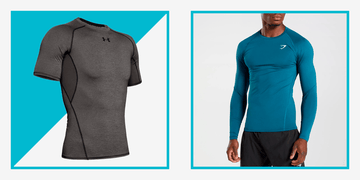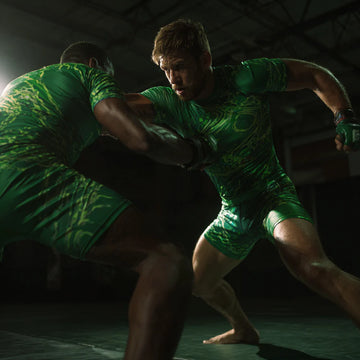1. Introduction to Rash Guards
Rash guards have become an essential piece of athletic performance gear, offering protection and comfort to athletes across various sports. The evolution of rash guard design has been driven by the need for enhanced performance, durability, and comfort. One of the most critical aspects of this evolution is the focus on seams and stitching in sportswear.
Understanding the intricacies of rash guard design begins with recognizing the importance of seams in rash guards. Seams are not just about holding the fabric together; they play a pivotal role in the overall functionality and comfort of the garment. The type of stitching used, whether flatlock stitching or overlock stitching, can significantly impact the rash guard's performance and durability.
Flatlock stitching, for instance, is known for its ability to create a smooth, flat seam that reduces chafing and irritation. This type of stitching is particularly beneficial for athletes who require a high level of comfort during intense physical activities. On the other hand, overlock stitching provides excellent strength and flexibility, making it ideal for sportswear that needs to withstand rigorous movements and stress.
As we delve deeper into the role of seams in rash guard design, it becomes evident that these elements are crucial for achieving the perfect balance between comfort, durability, and performance. The choice of stitching in sportswear is not just a matter of aesthetics; it directly influences the athlete's experience and performance on the field.
2. The Role of Seams in Rash Guard Design
Seams play a pivotal role in rash guard design, influencing both the functionality and comfort of the garment. The placement and type of seams in rash guards can significantly impact athletic performance and sportswear durability. When designed thoughtfully, seams can enhance the overall fit, ensuring that the rash guard moves seamlessly with the body during intense activities.
One of the primary considerations in rash guard design is minimizing chafing and irritation. This is where the importance of seams in rash guards becomes evident. Properly constructed seams, such as flatlock stitching, lie flat against the skin, reducing friction and enhancing rash guard comfort. On the other hand, poorly designed seams can cause discomfort and even skin abrasions, detracting from the athlete's performance.
Moreover, the stitching in sportswear, particularly in rash guards, must be robust enough to withstand the rigors of athletic activities. Overlock stitching, for instance, provides added strength and flexibility, ensuring that the garment remains intact even under stress. This attention to detail in sportswear design not only boosts the longevity of the rash guard but also supports the athlete's confidence and focus during performance.
3. Types of Seams Used in Rash Guards
When it comes to rash guard design, the types of seams used play a pivotal role in determining the garment's overall performance and comfort. Different seam types are employed to enhance the durability and functionality of athletic wear, ensuring that athletes can perform at their best without any distractions.
One of the most popular seam types in rash guards is the flatlock seam. Flatlock stitching involves overlapping two pieces of fabric and sewing them together, creating a flat, smooth seam that lies against the skin without causing irritation. This type of seam is highly favored for its ability to reduce chafing, making it ideal for high-intensity sports and prolonged wear.
Another common seam type is the overlock seam. Overlock stitching encases the raw edges of the fabric, preventing fraying and adding an extra layer of durability to the garment. This type of seam is particularly beneficial for sportswear durability, as it ensures that the rash guard can withstand rigorous activities and frequent washing without losing its integrity.
In addition to flatlock and overlock seams, some rash guards also feature reinforced seams in high-stress areas. These reinforced seams provide additional strength and support, ensuring that the garment can endure the demands of intense physical activity. By strategically placing these seams, designers can enhance the overall durability and longevity of the rash guard.
Understanding the different types of seams used in rash guards is essential for appreciating the intricacies of sportswear design. Each seam type offers unique benefits, contributing to the overall comfort, performance, and durability of the garment. Whether it's the smooth, chafe-free experience of flatlock stitching or the robust, fray-resistant qualities of overlock seams, these design elements are crucial for creating high-quality athletic performance gear.
4. The Importance of Stitching Techniques
Stitching techniques play a pivotal role in the overall quality and performance of rash guards. The way seams are stitched can significantly impact the durability, comfort, and functionality of the athletic wear. When it comes to rash guard design, the choice of stitching method is not just a matter of aesthetics but a crucial factor that determines how well the garment performs under strenuous conditions.
Flatlock stitching is a popular technique in sportswear design due to its ability to create strong, flat seams that lie close to the skin. This method minimizes chafing and irritation, enhancing rash guard comfort. On the other hand, overlock stitching is known for its strength and flexibility, making it ideal for areas that require extra durability. Both techniques contribute to the overall sportswear durability, ensuring that the garment can withstand the rigors of athletic activities.
In addition to durability and comfort, the right stitching technique can also enhance athletic performance. Well-constructed seams allow for greater freedom of movement, enabling athletes to perform at their best without being hindered by their gear. The importance of stitching in sportswear cannot be overstated, as it directly influences the effectiveness and longevity of the garment.
5. Common Stitching Techniques in Rash Guards
When it comes to rash guard design, the choice of stitching techniques plays a pivotal role in determining the overall quality and performance of the garment. Among the most common stitching methods used in athletic wear are flatlock stitching and overlock stitching. Each technique offers unique benefits that cater to different aspects of sportswear durability and comfort.
Flatlock stitching is renowned for its ability to create smooth, flat seams that lie close to the skin. This method involves overlapping two pieces of fabric and stitching them together in a way that minimizes bulk and reduces the risk of chafing. The result is a seamless feel that enhances rash guard comfort, making it an ideal choice for high-intensity activities where skin irritation can be a concern.
On the other hand, overlock stitching is celebrated for its strength and flexibility. This technique encases the raw edges of the fabric, preventing fraying and ensuring the longevity of the garment. Overlock stitching is particularly beneficial in areas of the rash guard that experience high levels of stress and movement, such as the underarms and sides. By providing a secure and durable finish, overlock stitching contributes significantly to the overall sportswear durability.
Understanding these common stitching techniques allows designers to create athletic performance gear that not only looks good but also performs exceptionally well. The careful selection of stitching methods ensures that rash guards can withstand the rigors of intense physical activity while providing maximum comfort to the wearer.
6. How Seams and Stitching Affect Performance
When it comes to athletic performance gear, the seams and stitching in rash guards play a pivotal role. These elements are not just about holding the fabric together; they significantly impact the overall performance and comfort of the sportswear. The type of stitching used, whether flatlock stitching or overlock stitching, can make a world of difference in how the rash guard feels against the skin.
Flatlock stitching is often preferred for its ability to lay flat against the skin, reducing the risk of chafing and irritation. This type of stitching is crucial for athletes who need to focus on their performance without being distracted by uncomfortable seams. On the other hand, overlock stitching provides excellent durability, ensuring that the rash guard can withstand the rigors of intense physical activity.
Seams in rash guards are strategically placed to enhance both comfort and functionality. Properly designed seams can improve the fit of the garment, allowing for a full range of motion. This is essential for athletes who require unrestricted movement during their activities. Additionally, well-constructed seams contribute to the overall durability of the sportswear, ensuring that it remains in top condition even after repeated use.
In summary, the importance of seams and stitching in rash guard design cannot be overstated. These elements are integral to the comfort, durability, and performance of athletic wear. By understanding the different types of stitching and their benefits, athletes can make informed choices about their sportswear, ultimately enhancing their performance and comfort.
7. The Evolution of Rash Guard Design
The evolution of rash guard design has been nothing short of revolutionary. Initially, rash guards were simple garments, primarily used for water sports to prevent chafing and sunburn. However, as the demand for high-performance athletic wear grew, so did the complexity and sophistication of rash guard design.
Modern rash guards are a testament to advanced sportswear design, incorporating cutting-edge materials and innovative stitching techniques. Flatlock stitching, for instance, has become a staple in rash guard design due to its ability to create strong, flat seams that reduce irritation and enhance comfort. Overlock stitching, on the other hand, offers excellent durability, ensuring that the garment can withstand the rigors of intense physical activity.
As the focus on athletic performance gear intensified, designers began to pay more attention to the placement and type of seams in rash guards. Strategic seam placement not only improves the fit and comfort of the garment but also enhances its overall performance. The integration of these advanced stitching methods has significantly contributed to the durability and functionality of modern rash guards, making them an essential piece of athletic wear for both amateur and professional athletes.
8. Tips for Choosing the Right Rash Guard
When selecting the perfect rash guard, several factors come into play. First, consider the type of stitching used. Flatlock stitching is ideal for reducing chafing and enhancing comfort, making it a popular choice in athletic wear. Overlock stitching, on the other hand, offers excellent durability, ensuring your sportswear can withstand intense activities.
Next, examine the seams in rash guards. Seams should be strategically placed to avoid high-friction areas, which can cause irritation during movement. Look for designs that prioritize both functionality and comfort, ensuring a seamless experience.
Material is another crucial aspect. Opt for high-quality, breathable fabrics that offer flexibility and moisture-wicking properties. This not only enhances athletic performance but also contributes to the overall comfort of the rash guard.
Lastly, consider the overall sportswear design. A well-designed rash guard should balance aesthetics with practicality, providing both style and functionality. By paying attention to these details, you can choose a rash guard that meets your needs and enhances your athletic performance.
9. Conclusion
Choosing the right rash guard can significantly impact your athletic performance and comfort. When selecting a rash guard, pay close attention to the seams and stitching. These elements are crucial for ensuring sportswear durability and rash guard comfort. Look for flatlock stitching, which lies flat against the skin, reducing chafing and irritation. Overlock stitching, on the other hand, provides strong, durable seams that can withstand intense physical activity.
Consider the overall rash guard design, including the placement of seams in rash guards. Seams should be strategically positioned to enhance mobility and reduce friction. High-quality stitching in sportswear not only improves comfort but also extends the lifespan of your athletic wear. By understanding these key aspects, you can make an informed decision and choose a rash guard that meets your needs for both performance and durability.





